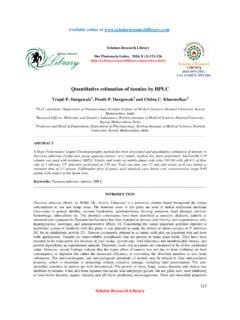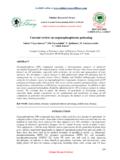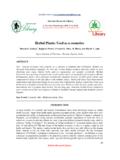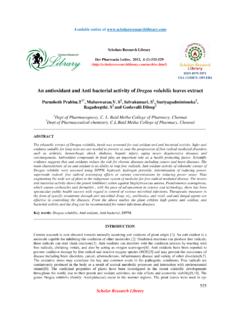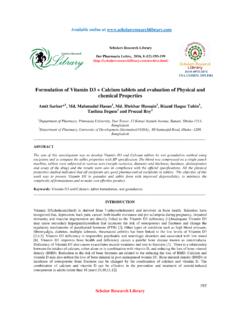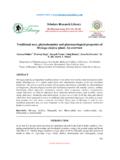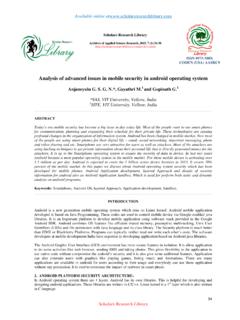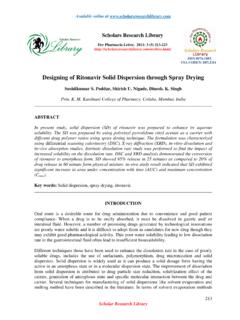Transcription of Comparative analysis of nutrient composition of milk from ...
1 Available online at scholars research library European Journal of Applied Engineering and Scientific research , 2014, 3 (2):33-36 ( ) ISSN: 2278 0041 33 scholars research library Comparative analysis of nutrient composition of milk from different breeds of cows *Dandare, S. U1, Ezeonwumelu, I. J2 and Abubakar, M. G1. 1 Department of Biochemistry, Usmanu Danfodiyo University, Sokoto, Nigeria 2 Department of Applied Biochemistry, Nnamdi Azikiwe University, Awka, Nigeria _____ ABSTRACT Exogenous nutrients supply in the human diet is required because of their biological significance for general life maintenance.
2 Milk is said to be the most unique and ideal class of food, because it meets the nutritional needs of the body better than any single food. This study investigated the major constituents of milk obtained from four different breeds of cows viz; Holstein Friesian (HF), White Fulani (WF), Red bororo (RB) and a crossbreed (HF+WF) found in Sokoto metropolis. Proximate parameters - moisture, ash, crude protein, lipid and lactose were determined using the AOAC methods while EDTA titration and spectrophotometric methods were used to determine calcium and phosphorus respectively.
3 The results of the proximate composition showed no significant difference (P> ) with the exception of the ash content which differed significantly (p< ) between the samples, with the crossbreed having the highest concentration of minerals ( ) and RB with the least value ( ), but has the highest concentration of calcium even though not significantly different from the others. The values of the moisture content ranged from , from (HF) to (HF+WF) for crude protein, and (HF) to (HF+WF) for the lipid content.
4 Overall, the local breeds (WF and RB) have shown more desirable nutritional qualities than the exotic breed (HF), however, crossbreeding showed a potential improvement in nutrients especially the protein content. A crossbreed between RB and HF holds a possibility of better nutrient yield, as this local breed (RB) appears to be a better dairy cattle than WF. Keywords: Milk, nutrient , Breeds of Cow, Calcium and Phosphorus. _____ INTRODUCTION Milk is a complex mixture of proteins, carbohydrates, vitamins, minerals and other constituents dispersed in water [1].
5 It is one of the oldest foods known to man [2]. On the basis of the protein content of milk, it is generally regarded as nature s most nearly perfect food owing to its rich protein profile containing more essential amino acids than any other natural food [3]. In addition, milk is an important source of mineral substances, especially calcium, phosphorus, sodium, potassium, chloride, iodine, magnesium, and small amounts of iron. Of these mineral constituents, calcium and phosphorus constitute a larger fraction in milk which is needed for bone growth and the proper development of newborns [4].
6 In humans, breast milk provides all the energy and nearly all nutrients required for infant growth and development during the first 4 to 6 months of life, as well as various immunological factors and bioactive components [5]. However, in the absence of breast-feeding, cow milk is commonly used as a weaning substitute for infants [6] often processed into various dairy formulas. Due to its high nutritive value, cow milk is widely consumed by infants and adults alike to meet their basic nutritional needs. Cow milk is the most universal raw material for processing dairy products resulting in the broadest spectrum of manufactured dairy products.
7 At present, the number of animals bred for dairy purposes abound which include Dandare, S. U et al Euro. J. Appl. Eng. Sci. Res., 2014, 3 (2):33-36 _____ 34 scholars research library Cattle, Goat, Sheep, Horse, Donkey and Camel [7]. In Nigeria, cattle (cow) provide more than 90% of the total animal milk output while goats and sheep provides less than 10% and are kept for production of meat, hides and skin [8]. The white Fulani popularly called Bunaji is the most numerous and wide spread of all the Nigerian cattle breeds accounting for about 37% of the national cattle population [9].
8 Subsequently, the Friesian breed was introduced in Nigeria and has been used to produce a stabilized crossbred Friesian + white Fulani cows whose dairy performance has been adjudged to be higher than the pure White Fulani [10]. One of the primary goals of the dairy industry has always been to improve the technological properties of milk, including its chemical composition . Milk processing suitability is significantly affected by the proportions of milk components. It has been shown that the quality of milk intended for consumption and processing varies subject to cattle breed [7,11].
9 Hence there is need to exploit the local and exotic breeds of dairy cattle in Nigeria in order to ascertain the best nutritionally enriched milk producer. MATERIALS AND METHODS Sample collection Four (4) different breeds of cows with an average age of years were used for this research . The breed names are Friesian, White Fulani, Red bororo and a cross breed between Friesian and White Fulani. The cows were found at Sidi Mamman Tsalha Asarkawa ( ) - a semi intensive farm at Sokoto metropolis, Nigeria. Early morning fresh milk samples were collected from the cows with separate containers using standard milking procedures.
10 To avoid contamination, containers used for sample collection were sterilized by soaking in 10% HNO3 for 24hours; then in distilled water for another 24hours after which they were rinsed with more distilled water and finally dried ready for sample collection. The collected samples were immediately packaged and transported for analysis . Proximate analysis Proximate parameters determined using the AOAC method. Moisture, ash, crude protein, crude lipid and lactose contents were determined by oven drying, furnace, micro Kjeldah, soxlet extraction and titrimetric methods respectively [12].

